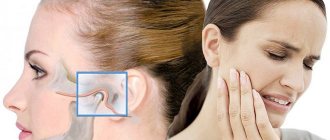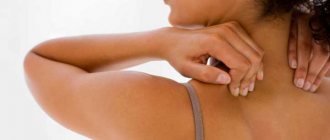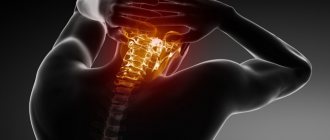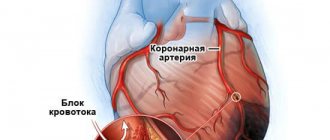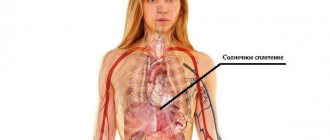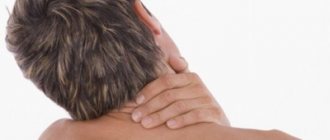Pain under the shoulder blade - this symptom can be encountered by both adults suffering from diseases of the musculoskeletal system or pathology of internal organs, and children who simply did not calculate the physical activity or were standing in a draft.
Self-administration of painkillers when subscapular pain occurs is absolutely unacceptable: such pain can be a sign of life-threatening conditions.
At the same time, not only acute pain, but also a dull pain under the left shoulder blade deserves attention and, often, emergency medical care.
The nature of the pain and accompanying symptoms help to suggest a particular disease. However, only a qualified doctor, based on the patient’s complaints, will be able to understand the damage to which organ caused the pain, prescribe the necessary diagnostic examination and, if necessary, provide emergency care.
General anatomical information
So, if you look at the back from the back, you can see that the left shoulder blade is fixed on the ribs that make up the chest. Between each of them there is a nerve and blood vessels located in the recesses. The ribs are connected to each other by ligaments and muscles.
Closer to the center of the shoulder blade is the spine, inside which the spinal cord is located. All the nerves come from him. The back muscles surrounding the shoulder blade are quite well developed. Its purpose is to protect the left lung, heart, spleen, stomach and pancreas, as well as the thoracic aorta.
general characteristics
The shoulder blade is part of the human shoulder girdle. It is connected to the ribs, the spine, and many nerves and vessels pass under it. The muscles of the arm, back, and ligaments coming from the spine are attached to the scapula. It protects the chest and the organs located in it at the back. On the left, under the shoulder blade, there is the heart, part of the pancreas, the left lung, and the aorta.
Therefore, pain in the area of the shoulder blades can be caused by various reasons. It may be associated with neurological pathologies, cardiac dysfunction, and diseases of the gastrointestinal tract. Any problems with the spine, intercostal muscles, or shoulder girdle can lead to similar discomfort.
Patients describe their feelings differently. Most often, they note that the pain is aching and not severe. This is explained by the fact that it gives off from the internal organs. But if the cause of the pathology is neurological problems or diseases of the musculoskeletal system, the pain can become sharp, intensifying with every movement.
Important: it is impossible to independently determine the cause of this condition. Therefore, you should definitely consult a doctor.
What factors provoke pain?
Pain under the left shoulder blade from the back can be caused by the following factors:
- Stomach ulcer. Here the nature of the back pain increases, it is associated with meals, but after an attack of vomiting it becomes weaker. An additional sign that it is the ulcer that provokes pain is the presence of belching or heartburn. Discomfort is felt not only in the left shoulder blade, but can also radiate to the sternum and left nipple. In this case, the patient is simply not able to move normally. Strong discomfort prevents him from taking a deep breath, so the person cannot relax completely, which entails other equally serious dysfunctions of the body and nervous system. If the pain on the left side of the back manifests itself too sharply, then you should immediately contact an ambulance.
- Acute pancreatitis. It can also cause quite severe pain in the left side of the back under the shoulder blade. The sensations have their own character, in this case overwhelming, sudden.
- Vegetative crisis. The manifestation of symptoms here is very clear. In addition to pain in the back left in the back, a person has a feeling of chest compression, heat in the same area, and the inability to establish the exact location of the discomfort. The patient is unable to breathe normally and experiences an increased feeling of anxiety and fear. It cannot be said that in such a state it will be possible to accurately determine the location of pain. It often radiates to other parts of the body, even to the lower abdomen. The patient experiences a feeling of a lump in the throat and suffocation.
- Myocardial infarction. It also causes severe pain in the area of the left shoulder blade from the back. This condition is often life-threatening, so it needs to be recognized in time and treatment started. The patient experiences a burning sensation and is unable to take a deep breath. The intensity of pain on the left side of the back is very high, the patient does not respond to nitroglycerin, and the pathological condition itself lasts more than 10 minutes. The disease is characterized by the fact that the patient’s hand often goes numb during an attack.
- Angina pectoris. This cardiac pathology is also characterized by the presence of pain under the shoulder blade on the left side of the back. The pain is sharp, squeezing the chest. The cause of this disease is considered to be a narrowing of the lumen of blood vessels. The attack is provoked by physical activity, hypothermia, and consumption of alcoholic beverages. Nitroglycerin can weaken it.
- Pathologies of the respiratory system. If a person feels constant pain from the back under the left shoulder blade, the cause of this condition is pneumonia or dry pleurisy. At the same time, unpleasant sensations accompany every deep breath, cough, and sneeze. The pain will always be directed towards the affected lung. Its character can vary depending on the severity of the pathology: it can be insignificant or become cutting and piercing.
- Dissecting aneurysm of the ascending aorta. Because of it, the load on the valve between the left atrium and the ventricle increases. At the same time, the heart cannot cope with its functions as quickly as necessary. This provokes stagnation of venous blood in the lungs, and their edema develops. At the point where the aneurysm attaches to the vessel, its wall becomes thinner and can rupture at any moment. This will cause serious bleeding into the abdominal cavity.
- Biphasic splenic rupture. This reason is considered very rare, but it does occur. When the tissue of the organ is damaged, the patient develops abdominal bleeding, which is almost impossible to stop. This disease requires immediate surgical treatment.
These pathologies must be recognized as quickly as possible. Otherwise, without receiving proper medical care, a person may die.
Treatment
After the doctor has determined through examination why the pain appears under the shoulder blade, he prescribes treatment. It should be aimed not only at reducing pain and restoring mobility of the shoulder girdle. Its main task is to eliminate factors that provoke discomfort and cure diseases that lead to pain. After all, most often the source of this condition is located in other organs, so simply relieving pain is impractical and can even be dangerous.
Treatment is prescribed by a doctor depending on the cause of the pain. The general method for any disease is drug therapy. For heart diseases, cardiac medications are taken, for gastrointestinal pathologies - antacids, for diseases of the musculoskeletal system - non-steroidal anti-inflammatory drugs. In addition, for any pathologies of internal organs, a diet must be prescribed. This is especially important for diseases of the stomach and pancreas.
If such pain is caused by diseases of the musculoskeletal system, treatment will be long-term and must be comprehensive. One of the main methods of therapy is the use of physical therapy, massage and physiotherapeutic procedures.
Sometimes, if conservative therapy is ineffective, surgery is required. It is necessary for perforation of an ulcer, heart attack or herniated disc. But usually such a condition is treated with traditional methods, the main thing is to consult a doctor in time.
What diseases of the musculoskeletal system provoke pain?
Damage to the spine or other parts of the skeleton can cause pain under the left shoulder blade from behind. The following reasons for the development of discomfort can be identified:
- Osteochondrosis of the neck. At the beginning of the development of the disease, the patient’s sensations are difficult to determine, but they are directed towards those nerve roots that are damaged. The pain is spontaneous, nagging, and may go away after taking a warm bath. In the neck area, severe pinching of nerves and blood vessels subsequently occurs, which does not go unnoticed. An additional symptom of the pathology is that the pain radiates to the arm. Osteochondrosis of the neck develops most often in those people who intentionally or forcedly lead a passive, sedentary lifestyle. As for the nature of the pain syndrome, there may be aching or stabbing under the shoulder blade.
- Damage to the intercostal nerves. The presented condition is considered a common cause of back pain under the shoulder blade on the left. Taking a deep breath, coughing, and bending to the left side increases the pain syndrome. The sensations are very sharp, strong, shooting. If the pathology progresses, then the pain under the shoulder blade from behind becomes burning.
- Scapular-costal syndrome. The sensation is usually aching, pulling. Discomfort is localized in the area above and below the shoulder blade, below the shoulders. A feature of the pathology is that a crunching sound can be heard while moving the arm and shoulder. The cause of this disease is very strong physical stress, injury to the specified part of the body, and hypothermia.
- A malignant tumor affecting the skeleton. In this case, the tumor itself or its metastases are localized on the scapula.
- Scapular crunch. This disease is not observed very often and affects the subscapular bursa. The pain here is not of high intensity. But during movement, a crunching sound is heard in the area of the shoulder blade.
- Osteomyelitis that occurs as a result of a specific injury, for example: a wound from a weapon.
- Humeroscapular periarthritis. If it has a simple form of development, then the sensations will not stand out too clearly. Symptoms are usually detected only with some movement. During the acute stage of development, the pathology is characterized by an increase in appearance, especially at night. At the same time, mobility in the shoulder is limited, an increase in basal temperature is observed, and the muscles spasm.
Pain under the left shoulder blade can be a symptom of severe pathology, especially if it is burning, sharp or stabbing in nature. Even pregnancy can provoke a pathological condition. This period is characterized by the fact that the female body experiences enormous stress.
An injury can trigger pain in the back under the left shoulder blade: a fracture, a crack. Here the discomfort is aching in nature, and with movement there is a tendency to intensify it. Psychosomatic reasons for the development of such a pathological condition are quite often noted. The provoking factor here is severe emotional or psychological stress, which the body is not able to adequately cope with. The peculiarity of this reason is that even a negative attitude of the patient towards the symptoms can worsen his well-being even more.
Neurologist, candidate of medical sciences Kabirski Sef Georgievich talks about the disease in this video:
Neuropathic pain under the left shoulder blade
Neuropathic pain is a fairly common type of pain in this localization, so diagnosis for complaints of pain under the scapula always begins with excluding possible neurogenic causes (after excluding the traumatic factor).
Neuropathic pain – what is it?
The scapula is a bone located in the upper shoulder girdle and serves as the articulation of the skeletal base of the shoulder (tubular humerus) and the collarbone. The anterior surface of the scapula has a slightly concave shape and is called the costal surface. The posterior surface (dorsal) is adjacent to the spinal column, which consists of five sections and vertebrae connected in a vertical sequence, therefore one of the main causes of pain in this localization is diseases of the spine.
Blade structure
The most common vertebral pathology (the frequency of detection in patients over 40 years of age is more than 60%) is osteochondrosis. With osteochondrosis, compression and deformation of the spine occurs, which leads to the progressive destruction of the main “shock absorbers” of the central axial skeleton - the intervertebral discs. This is the name for round, elongated formations consisting of ring-shaped fibrocartilaginous plates and filled with a gelatinous mass called the nucleus pulposus. The intervertebral disc pulp contains collagen and water, which are necessary to maintain the firmness and elasticity of the spine.
Dystrophy of the intervertebral disc provokes dehydration and drying of the jelly-like core and fibrous membrane, which leads to the formation of hernias and protrusions - displacement of the pulp outside the disc space. Pulpous protrusions can cause compression of the spinal nerves and active irritation of nerve cells, causing neuropathic pain. This is the name of a pain syndrome that develops against the background of excitation of neurons in the central or peripheral nervous system.
Pain and neuropathic pain
Causes of neuropathic pain
Neuropathic pain of mild or moderate intensity in the area of the shoulder blades in most cases is a consequence of osteochondrosis and its complications. It should not be confused with radicular syndrome (radiculopathy), pain in which is caused solely by compression of nerve endings - nerve bundles located on the processes of nerves and providing the transmission of information in the form of impulses. Neuropathic pain in neuralgia against the background of osteochondrosis and intervertebral hernias and protrusions is caused by direct stimulation of sensory neurons, and the distinctive features of this pain syndrome are a long duration and the lack of effect from the use of traditional analgesics to relieve attacks.
Spine structure
Other possible causes of neuropathic pain also include:
- injuries of the nerve trunks and spinal cord at the level of the thoracic and thoracolumbar spine;
- diabetes mellitus and other endocrinological pathologies;
- cerebral stroke;
- various polyneuropathies (including the alcoholic form), in which multiple damage to the peripheral nervous system occurs.
Note! Periodically recurring neuropathic pain is the most important symptom and manifestation of cancerous lesions of bones, muscles and soft tissues located in the subscapular fossa. Such pain can be accompanied by sleep disturbances, irritability, depression and combined with autonomic and motor disorders.
Depression is one of the symptoms of cancerous lesions of bones, muscles and soft tissues
Classification of unpleasant sensations
Before starting treatment for a pathological condition, it is necessary to determine the cause of their occurrence. The nature of the pain syndrome is also important for diagnosis. He can be:
- Shingles. In this case, the discomfort is localized in one place. A person feels it all the time. The patient cannot breathe normally, as this leads to an increase in the syndrome. The slightest movement or cough can provoke a deterioration in the patient’s condition. The nature of the pain is provoked by the passage of a nerve impulse between the ribs.
- Burning. The victim may experience numbness in certain areas of the skin and a tingling sensation in the body.
- Growing. Here the pain from under the shoulder blade on the side of the back will radiate into the arm. Increased muscle tone in the shoulder and back can provoke these symptoms.
- Spicy. Here the intensity of pain behind the left shoulder blade is considered very high. Often the patient cannot breathe, it is difficult for him to lie on his left side, movements become unbearable.
- Cutting. It is first localized on the left, and then moves to the center.
- Dull, aching pain in the left shoulder blade. It usually occurs when you raise your arm.
- Nagging pain syndrome. It often “spreads” from the shoulder blade to the lumbar spine.
- Cutting.
- Constant pain that prevents you from breathing normally, lying down, or moving.
As you can see, there are quite a lot of different types of discomfort. Therefore, it will not be possible to accurately determine the cause of the development of pathology on your own. That is, if there is pain, the patient needs to see a doctor and undergo a thorough examination.
Musculoskeletal system
Pathologies of the musculoskeletal system are provoked by various injuries:
Why does my upper back hurt?
- fractures and cracks caused by impacts, falls, road accidents, etc. The aching pain intensifies when a person makes movements. Also, the damaged area swells, a bruise appears, and mobility decreases;
- dislocations, which are observed in rare cases and occur when there is a strong pull on the arm or a blow to the shoulder blade. In this case, the bone rotates, shifts, and takes on an abnormal position. Its lower edge is compressed between the ribs.
The muscles connecting the scapula and spine are subject to excessive stress, causing stretching and possible rupture.
Pain in the area of the left shoulder blade on the back caused by injury occurs immediately after the injury and only goes away as the patient recovers.
In addition to injuries, pain in the area of the shoulder blade from the back is often caused by diseases of the musculoskeletal system.
Pain syndrome under the scapula, which is a consequence of cervical osteochondrosis (dystrophic-degenerative processes in the intervertebral discs of the spine), is spontaneous and can be aching and pulling. Increased pain is observed when a person remains in a sitting position for a long time and during physical exertion. Taking medications does not bring relief.
A pinched, inflamed intercostal nerve causes unbearable pain in the sternum, in the area where it lies. The syndrome intensifies as a person moves, when he coughs, sneezes, inhales deeply, and changes body position. Constant or paroxysmal pain syndrome is sharp, strong, shooting in nature. Sometimes pain manifests itself in the heart area, in the lower back, and affects the neck and arms. It can also affect the shoulder blade.
Manifestations of intercostal neuralgia are similar to symptoms caused by cardiac problems, cholecystitis, angina pectoris, and pleurisy. Only a qualified specialist can make a correct diagnosis
When there is inflammation in the shoulder tendon and capsule of the shoulder joint without damage to the joint and cartilage itself (humeral periarthritis), pain affects the shoulder joint, sometimes the area between the shoulder blades and the bone itself. They are sharp and intensified at night. The disease is accompanied by slight swelling of the shoulder, elevated temperature in the range of 37–37.4ºС, and limited circular movements of the shoulder. The pathology is widespread and is diagnosed as a consequence of injuries, bruises, and increased loads on the shoulder joint.
With inflammation of the cervical muscles (myositis), caused by overstrain or infection, severe pain affects the entire cervical-brachial region, radiating to the scapula, occipital region, and arms.
Muscle pain in the scapula area occurs due to physical strain or impact on the bone.
Pain due to malignant lesions of the bone structure or soft tissues refers to the initial manifestation of the disease. At first, they do not differ in intensity and appear periodically, which makes timely diagnosis difficult. The development of pathological processes leads to an increase in the severity of negative sensations that haunt a person even at rest, mainly at night. Not eliminated by non-narcotic analgesics. Next, the bone becomes deformed, the surrounding tissues swell, the skin over the malignant focus changes, and fractures occur that are not associated with trauma.
In the presence of an inflammatory process in the bone (osteomyelitis) caused by streptococci, staphylococcus, salmonella, E. coli and other infectious agents, the patient is exposed to high fever, chills, and increased heart rate. There are complaints of back pain in the scapula and muscles, which decrease when the abscess is opened.
Please note! Painful manifestations under or above the left shoulder blade and in the bone area are inherent in congenital anomalies. These include aplasia (absence of an organ), hypoplasia (insufficient bone development), pterygoid scapula, and Sprengel's disease. At the same time, a person often suffers from cosmetic defects and limited motor activity.
Intervertebral hernia and protrusion of the discs of the cervical spine lead to compression of the nerve roots by bone formations, which causes pain when moving, especially when tilting the head.
Features of disease diagnosis
If the patient feels a dull pain and begins to ache in the area of the left shoulder blade, treatment begins with a full examination. Diagnostics involves the following procedures:
- X-ray of the spine, and it is performed in several projections. The image may also show problems with the lungs.
- CT scan.
- MRI.
- If there are cardiac symptoms, the patient is prescribed an ECG.
- Ultrasound of internal organs.
- Instrumental examination of pulse and blood pressure.
- Biochemical and general blood test
After examination and determination of the cause of the pathological condition, the patient is prescribed treatment. He may also need to consult a cardiologist or gastroenterologist.
Gastrointestinal diseases
The pain syndrome is localized in the left hypochondrium. It forms immediately or several hours after eating.
| Gastrointestinal pathology | Description | The nature of the pain | Additional signs |
Pancreatitis | A group of diseases and syndromes in which inflammation of the pancreas occurs. | Strong, sharp, often forces you to take a forced position in which the pain is felt less. The nature of the pain can be girdling or radiate to the back or epigastric region. | Symptoms of intoxication (lack of appetite, fever, nausea leading to vomiting, weakness). The stool may become mushy. In this case, there will be undigested pieces of food. |
Stomach ulcer | Chronic polyetiological pathology. Characterized by the formation of ulcerative lesions in the organ. Progresses quickly. In 60% of cases, complications develop against its background. | Growing. If the body of the stomach is affected, the pain is localized to the left of the center line of the body. The intensity increases within half an hour to an hour after eating. Late (3-4 hours after eating), hungry and night pain may appear. | Coated tongue, belching, heartburn, bad breath, alternating constipation with diarrhea. Vomiting brings temporary relief. |
Gastritis | Inflammation of the gastric mucosa. | Aching, sharp. | Decreased appetite, flatulence, nausea (sometimes it turns into vomiting). Immediately after finishing a meal, a feeling of fullness occurs in the upper abdomen. |
*Click on image to enlarge
How to properly treat the disease?
Naturally, if the patient begins to ache in the back of the left shoulder blade, he cannot take a deep breath, he should begin therapy. Methods for eliminating pain under the left shoulder blade are determined by the factors that triggered the development of the pathological process. It is not enough to simply eliminate the symptoms, as they will quickly reappear.
Any disease is characterized by its own symptoms, therefore the treatment regimen is always different. However, each of them contains important recommendations for maintaining a daily routine and diet. Naturally, dull pain is treated with the use of medications.
Elena Malysheva and her assistants talk about how to relieve pain in their television program:
If conservative therapy does not provide positive dynamics, surgery is indicated for the patient. For example, a hernia of significant size, a rupture of the spleen, or a stomach ulcer accompanied by internal bleeding must be surgically treated.
If pain provokes pregnancy, then you should rest more and consult a gynecologist.
conclusions
Pain under the left shoulder blade is an uncommon occurrence. Although this condition can affect anyone, similar pain can occur in men, women, and children. Most often, they are caused by muscle strain, prolonged exposure to an uncomfortable position, or injury. But there are also more serious chronic or acute pathologies, one of the symptoms of which is pain under the left shoulder blade. Without treatment, they can lead to serious complications, so when such pain occurs periodically or gradually intensifies, you should definitely consult a doctor.
When should you go to the hospital?
So, if discomfort is constantly present, and with deep breathing it becomes stronger and begins to radiate to the arm and other parts of the body, you should immediately consult with specialists. Simply treating symptoms will only make the situation worse as the disease continues to progress.
Even if the patient knows the cause of his condition, he should not immediately run to a specialist. It is better to consult with a therapist, who will direct you where you need to go.
Preventive measures
It is impossible to completely insure yourself against all diseases. However, you can try to avoid those factors that will cause deterioration in health. For example, you should eat right, do daily exercise to keep your body toned and train your muscles. If you have sedentary work, warm-up is periodically required. Naturally, it is better to avoid all kinds of injuries.
If you know why it hurts under the left shoulder blade at the back, then you can start effective treatment in time. Naturally, some pathologies, especially degenerative-dystrophic ones, cannot be completely overcome. However, proper therapy will help slow their progression. Be healthy and do not neglect the advice of specialists!
Prevention
To prevent pain, it is necessary to know the cause of its occurrence. Only then can you achieve the desired effect in preventing pain. Patients suffering from angina pectoris, heart disease or a heart attack should always take cardiac medications, follow a proper diet, and limit physical and psychological activities.
Spinal disease requires long-term treatment, during which special therapeutic exercises are performed and non-steroidal medications are taken to prevent inflammation.
Stomach diseases require proper diet and special medications. These diseases require the intervention of a psychologist to maintain the patient’s emotional psychological balance. Prevention requires regular medical examinations. Consulting a doctor and undergoing preventive examinations result in a low percentage of the appearance of pain and illness in the near future. These measures are simply necessary. After all, it is easier to prevent pain between the shoulder blade and the spine on the left than to get sick and be treated.
| Please rate the article |
I RECOMMEND ON
What does the left shoulder blade connect to?
Let's consider which organs the left shoulder blade contacts from the back. It is an element of the belt of the upper left limb and one of its processes is attached to the ribs of the chest. Between the ribs lie nerve fibers and blood vessels, which occupy a specially designated recess. They are connected by intercostal muscles and ligaments.
Closer to the center of the body from the left shoulder blade is a ridge, in the middle of which is the spinal cord. It gives rise to the nerves that pass between the ribs. The scapula is surrounded by well-developed dorsal muscles. In combination with the left segment of the chest, the scapula, in addition to its main function, protects the lung on the left side, the heart muscle, the stomach with the pancreas, the spleen and part of the largest blood vessel - the aorta.
Based on knowledge of human anatomy, we can divide the causes of pain in the left shoulder blade into those that appear due to pathological processes of the musculoskeletal system and muscles, and those that indicate the onset of a pathological process in the above internal organs.
To find out the cause of the pain that occurs under the scapula on the left, the patient needs to clearly listen to the nature of the pain, the time of its onset and duration. This will help the doctor quickly discover the cause of this symptom and prescribe effective treatment.
Differential diagnosis
If painful sensations occur specifically under the right shoulder blade, it is also necessary to exclude pathologies of internal organs (pain in this case can have both a local and reflected course). Diagnosis of such pain is quite complex, so it is necessary to evaluate the pain syndrome only in conjunction with other clinical signs.
Table. Possible causes of pain under the right shoulder blade.
| Affected organ (or organ system) | Possible diseases | Symptoms (other than pain) |
| Gallbladder | Cholecystitis, polyposis, biliary sludge, bile duct dyskinesia, gallbladder cancer. | Unpleasant taste in the mouth (bitterness and metallic taste), putrid breath, abdominal pain, upset stool. Most patients suffer from heartburn, nausea, and dysgeusia (taste distortion). The skin and mucous membranes may take on a yellowish or lemon tint. In acute inflammation, repeated and profuse vomiting with an admixture of bile acids is possible. The localization of pain under the scapula is not typical for gallbladder pathologies, but in rare cases, with a reflected course, patients may complain of pain in this area. |
| Right kidney | Glomerulonephritis, pyelonephritis, kidney prolapse, nephroptosis. | Dysuric disorders (residual urine, frequent and painful urination, false urge to empty the bladder). With infectious inflammation of the renal parenchyma, an increase in body temperature and general manifestations of intoxication syndrome are possible: weakness, headache, lack of appetite. In the urine of various kidney pathologies, sediment in the form of flakes or a bloody suspension can be detected. |
| Right lung | Bronchitis, pneumonia. | Pain when inhaling, shallow, rapid breathing, cough, sputum (sometimes with blood). |
Subphrenic abscess can be classified as a separate category. This is an abscess, a cavity filled with inflammatory or purulent exudate, which usually forms as a complication of perforated ulcers of the cardial part of the stomach.
Right subphrenic abscess
Treatment of abscesses is almost always surgical, followed by antibiotic therapy and antimicrobial prophylaxis (Metronidazole, Amoxicillin, Tetracycline).
"Metronidazole"
Medicines
Treatment for pain depends on the underlying cause. If it is associated with muscle strain, bruises, disorders in the bony area of the scapula, then painkillers, non-steroidal anti-inflammatory drugs, and muscle relaxants are used. At the next stage, heat and physical therapy help.
| Name of drugs | Mode of application |
| Nimesulide | Prescribed for acute pain, take the drug after meals, 1 tablet. 2 times a day |
| Indomethacin | Used in the form of tablets for various diseases of the articular syndrome, prescribed from 25 to 50 mg 3 times a day. It is used externally for exacerbation of joint diseases: ointment and gel are applied no more than 2 times a day. |
| Ibuprofen | The daily dose of tablets depends on the cause of the pain; you can use a gel or cream, applying and rubbing until completely absorbed 3-4 times a day. |
| Mydocalm | Relaxes muscles, increases their tone, take 1 tablet in tablet form. per day, maximum dose – 3 pcs. The solution is used intravenously, no more than 100 mg per day, intramuscularly no more than 200 mg. |
For treatment, ointments are used that provide a long-term warming effect:
- Finalgon.
- Diclofenac.
- Viprosal.
- Capsicam.
If you experience pain under your right shoulder blade with increasing intensity, you should consult a medical professional rather than self-medicate.
Types of pain
Acute
Acute or stabbing pain accompanies several diseases:
- protrusion or herniation of intervertebral discs, pinched nerve roots,
- peptic ulcer in the acute stage,
- myocardial infarction,
angina pectoris.
Short-term, rarely lasting more than a few minutes.
Dumb
Dull pain is a hallmark of osteochondrosis of the cervical and thoracic regions. It usually feels good in the morning, when sitting in one position for a long time, when the muscle corset is tense.
It goes in the direction from the back of the head and below - to the shoulder blades, arms, back. Accompanied by headache, numbness of fingers, tingling. Characterized by the duration of the course.
Aching
This type of pain in the subscapular area is a sure sign of osteochondrosis of the cervicothoracic region. May be accompanied by numbness and restrictions in the movements of the left hand.
This discomfort also indicates myocorditis, one of the heart diseases. It is accompanied by shortness of breath and pallor, exacerbations, and has an unstable character caused by fatigue and stress.
Has a long duration. After some time, a person gets used to it and stops perceiving it as something abnormal.
Strong
This type indicates myocardial infarction and pre-infarction condition, as well as a stomach ulcer. In heart diseases, it manifests itself along with sensations of burning and squeezing. It is short-term in nature.
Stabbing
Stitching pain accompanies pleurisy. She is accompanied by weakness and sweating. Is of a long-lasting nature.
Pressing
Bursting, pressing discomfort under the left shoulder blade is a characteristic sign of vegetative-vascular dystonia. The main difference from cardiac and osteochondrosis pain is the lack of connection with physical activity. Has a duration.
Pulsating
Shows spinal diseases of various etiologies. Accompanied by numbness of the hands, pressure surges and weakness. Lasts a long time.
What to do if there is pain under the right shoulder blade?
It is not recommended to take any measures on your own to treat pain under the scapula, since the list of reasons that can provoke pain in such localization is quite extensive. To find out, you need to go to the hospital and undergo the necessary examination, which necessarily includes an x-ray of the scapula to exclude possible injuries and fractures.
First aid for a fracture
When a scapula is fractured, the first aid algorithm usually looks like this.
- Anesthetize the fracture site. If possible and the necessary knowledge, it is best to use a solution of novocaine or procaine for injection. In their absence, you can give the victim any analgesic, for example, metamizole sodium (Baralgin, Analgin).
"Analgin"
- If there are no visual signs of displacement of bone fragments, place a rolled up towel or jacket in the armpit.
- Bend the arm on the side of the injury at the elbow and secure it on the chest with a scarf or scarf.
First aid
After specialized care is provided in the emergency room, the bandage should be worn for another 14-20 days.
Muscle strain: what to do?
When the subscapularis muscles are sprained, the most effective method of pain relief in the first two days is cold compresses (a heating pad with ice, a wet cloth, etc.). You need to hold them for about 10-15 minutes, repeat the procedure up to 5-6 times a day.
Using an ice pack
Starting from the third day, treatment usually includes the following drugs:
- NSAIDs in the form of ointments and tablets (Diclofenac, Ibuprofen, Nimesulide);
- warming ointments with bee venom or camphor alcohol (“Capsicam”, “Viprosal”);
- gels and ointments with angioprotective effects (“Troxerutin”, “Heparin ointment”).
"Viprosal"
After the pain disappears, the use of gentle exercise therapy techniques and physiotherapeutic treatment is indicated, which is necessary for the complete restoration of the damaged muscle.
Note! In severe cases, sprained subscapularis muscles may require the use of a special corset or bandage, so any treatment should only be prescribed by a specialist.
How to treat bursitis?
To treat subscapular bursitis, in most cases antibiotics are used (mainly fluoroquinolones and semisynthetic penicillin drugs). Antibacterial therapy can also be prescribed for prophylactic purposes in aseptic inflammation to prevent infection against the background of prolonged or intense inflammation. To stop the inflammatory process, drugs from the NSAID group (Diclofenac, Meloxicam), as well as steroid hormones (Hydrocortisone, Prednisolone) are used.
"Diclofenac"
In severe cases and the ineffectiveness of conservative methods, the patient is prescribed surgical drainage of the synovial cavity, followed by rinsing with antiseptics.
Video - Pain under the scapula
Subscapularis pain is an alarming symptom that requires a full and comprehensive diagnosis. It can be both a manifestation of injuries and a sign of chronic musculoskeletal pathologies, for example, osteochondrosis. In some cases, differential diagnosis with diseases of internal organs is required, so self-medication for pain of such localization is unacceptable.
Diagnostics
To identify the cause of discomfort in the area of the scapula and below, laboratory and instrumental examinations are carried out:
- X-ray or CT scan - using these methods you can detect osteochondrosis, spinal curvature and the consequences of injuries.
- MRI – the spinal column, shoulder joint or internal organs are examined, depending on the suspected pathology.
- ECG - helps to identify cardiac diseases.
- Blood and urine tests are informative for some somatic pathologies, inflammation of muscles and joints.
- Ultrasound – is prescribed for somatic diseases, if it is impossible to undergo an MRI.
Typically, pain below the shoulder blade occurs due to neurology. Therefore, CT and MRI are considered the “gold standard” in the diagnostic protocol.
Stomach ulcer
Pain in this disease is localized in the epigastric region of the abdomen, but can also spread under the left shoulder blade and left side of the chest. The pain is increasing in nature. Its occurrence is directly related to nutrition.
Therefore, pain is conventionally divided into the following types:
1. Early pain develops immediately after eating and gradually calms down as the stomach is emptied.
2. Hunger pain begins quite a long period of time after the last meal.
3. Late type of pain is characterized by its occurrence within the next few hours after eating. This is its main difference.
4. Night pain is somewhat similar to hunger pain, but it’s not just the stomach that hurts. Pain also extends to the lumbar back.
Pain in the left shoulder blade due to pathologies of the muscles and skeleton
For dysfunction of the musculoskeletal system and back muscles, a characteristic symptom is pain in the back of the left shoulder blade. This may be a sign of damage to the spinal column due to, for example, osteochondrosis, intervertebral hernial protrusion or scoliosis of the thoracic spine. During these pathological processes, pressure is exerted on the nerve roots of the spinal cord, which causes severe pain in the patient. They can cause suffering to a person all the time, or they can occur periodically in the form of lumbago. In this case, discomfort is felt in the thoracic spine, as if there is a foreign body between the vertebral bodies.
Pathological conditions in the cervical vertebrae can manifest as pain in the area of the left shoulder blade due to the nerves of the cervical spinal cord lying next to it.
The development of glenohumeral periarthritis in a person can also provoke severe pain under the scapula. This is due to the fact that one of the processes of the scapula, connecting to the humerus, forms the shoulder joint.
The patient may experience aching pain due to the development of scapular-costal syndrome. The pain symptom covers the inside of the bone, extending to the neck and shoulder area. This disease develops against the background of hypothermia, injury or overexertion.
Diagnosis of subscapular pain
When collecting anamnesis, the doctor pays attention to the connection between pain and physical activity, food intake, stress, and also clarifies concomitant chronic and recent diseases.
Assessing the nature of pain, the presence of certain symptoms specific to diseases of different organs allows us to narrow the range of causes to a specific body system - heart, lungs, musculoskeletal system, gastrointestinal tract. The preliminary diagnosis is confirmed by the following studies:
- heart - a/d measurement, ECG, echocardiography and Doppler scanning;
- lungs - chest x-ray;
- spine - x-ray of the cervical and thoracic spine, CT or MRI.
In the future, a more detailed examination of the damaged organ may be required. Only then is treatment for the identified disease prescribed.
When and which doctor should I contact?
Depending on the degree of intensity and nature of the pain under the shoulder blade and accompanying symptoms, you should consult a doctor:
- urgent call for emergency assistance - sudden pain with increasing intensity and rapid deterioration of general condition;
- traumatologist - receiving an injury that provoked pain;
- cardiologist - for concomitant chest pain (constant or intermittent), shortness of breath, cyanosis;
- neurologist, orthopedist - pain under the left shoulder blade, intensifying when raising the arm, there is a clear connection between the occurrence of pain and physical activity, previously diagnosed degenerative pathology of the spine;
- gastroenterologist - there is a connection between pain and food intake, there are other signs of gastrointestinal disease (nausea, vomiting, etc.);
- pulmonologist - pain under the shoulder blade is accompanied by cough, shortness of breath;
- therapist - pain occurs without a clear reason, permanent or temporary.
It is the therapist who often diagnoses both trivial VSD and finds confirmation of acute surgical pathology or an oncological process. Subsequently, the doctor prescribes a consultation with a specialist.
Causes of pain between the shoulder blades
Taking into account the above, several groups can be distinguished among the causes of subscapular pain:
- lifestyle disorder;
- injuries;
- infectious-inflammatory process;
- diseases of internal organs.
Causes of spinal column pathology that we can control:
- lack of nutrition and microelements (deficiency of calcium, phosphorus, magnesium, zinc, silicon, protein leads to degradation of cartilage and bone tissue);
- inactivity (muscle spasms are observed, weakening of the muscle corset provokes curvature of the spine, hernia);
- hard work with improper load redistribution (provokes premature wear of skeletal structures, muscle pain and injuries);
- frequent hypothermia (triggers the development of an inflammatory process in tissues).
On a note! Separately, it is worth mentioning the hormonal background of the body. If the endocrine system malfunctions, the body may actively lose calcium. This is why women, bodybuilders, and people undergoing steroid treatment have back pain in the area of the shoulder blades. When carrying a child, the situation may also worsen. Against the background of a deficiency of microelements, the load on the muscular-ligamentous apparatus increases, which is why many women have back pain in the area of the shoulder blades even after childbirth.



